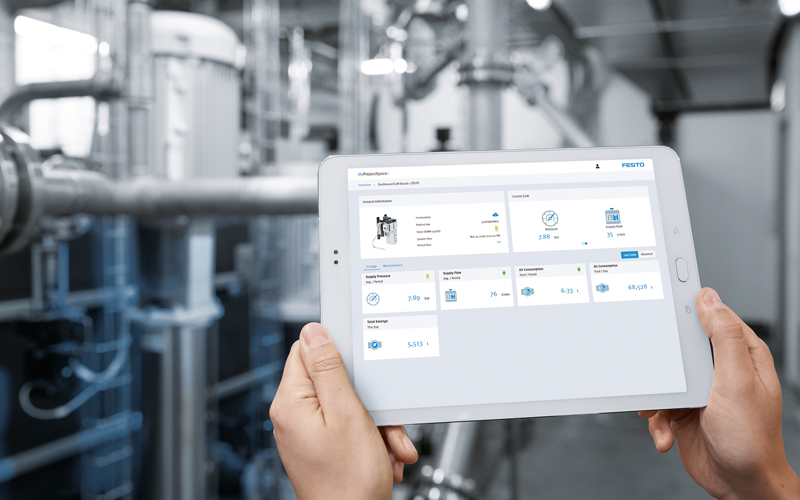Great strides into the digital future

Digitalisation and artificial intelligence (AI) are mega trends that are also opening up the potential for savings in all phases of a plant's lifecycle in process automation. A digital field device, the Festo Motion Terminal VTEM, is already available. Festo Dashboards also visualise plant conditions and even artificial intelligence is no longer far removed from becoming a reality in process automation.
Just like the smartphone provides different functions on a standardised hardware platform using apps, Festo also implemented the concept of separating hardware and user software in the Motion Terminal VTEM. So-called Motion Apps make it possible to carry out 50 different pneumatic applications in the VTEM using apps.
This eliminates the contradiction between standardisation and flexibility. The VTEM combines mechanical system, electronics and software. Valve terminal technology with piezo technology is used as the basis and is equipped with additional sensors. Apps such as for end position detection for on/off process valves eliminate the need for additional components such as traditional limit switch boxes for end position detection. Other examples are the apps “ECO drive” and “Leakage diagnostics”.
App reduces compressed air consumption by up to 50%
Almost every design engineer includes a generous safety reserve when sizing the pneumatic actuators for a plant. As a result, most actuators have more torque and force than required for the actual working stroke. This is particularly noticeable in the compressed air consumption of plants in continuous operation. The "ECO drive" Motion App is able to pare down the increased compressed air consumption caused by the safety factor and the actuator size and reduce the pressure in the actuator to the minimum required for the application. Experience has shown that energy savings of up to 50% are possible.
App diagnoses leakage
The “Leakage diagnostics” Motion App enables leaks to be detected without interrupting production. That saves time and money. Leaks in the compressed air system can be detected and localised to specific actuators in separate diagnostic cycles. Predefined threshold values thus allow precise and preventive maintenance. Laborious troubleshooting in extended compressed air networks is no longer necessary. Maintenance staff can start working on eliminating the leaks immediately.
Dashboards provide overview
Detecting irregularities at an early stage and initiating the necessary measures before a system failure can now be done with the dashboards and IoT gateway CPX-IOT from Festo. The turnkey, preconfigured dashboards from Festo do not need any additional programming or installation of software. The data improves operating transparency for production managers and operators.
Further processing and long-term analysis of data takes place in the cloud. Festo Dashboards visualise the information gathered. Through the visualisation and processing of data Festo supports plant builders and end users in several steps. The result is increased productivity through better utilisation, lower costs through greater energy efficiency and fewer downtimes thanks to comprehensive diagnostics, condition monitoring and improved maintenance. Plant operators can compare the process control systems of their plants across several locations and identify potential for saving energy. The data can be called up at any time.
Controlling pneumatic actuators – soon with AI…
Having the positioner function in a decentralised control unit, in other words not directly at or in the actuator, opens up new horizons right up to the use of artificial intelligence. This starts with the decentralised automation of modular plants. When using the Module Type Package (MTP) approach of ZVEI/NAMUR, a module in higher-level control systems can be easily visualised, and communication can be established at little extra cost.
The next step is the decentralised implementation of machine learning algorithms – on edge, in other words at the specific production stage to be monitored. Decentralised monitoring of actuator characteristics, such as pressure in the actuator chambers, travel speeds and their correlation over time, not only enables the parameters of the actuator itself to be analysed, but also allows anomalies in the technical process to be detected. This is the basis for predictive maintenance concepts and for data analyses aimed at optimising the production process. The artificial intelligence in the module controller detects any anomalies without the need for additional programming.
The algorithms are taught in based on a database representing normal production, allowing them to independently detect deviations in the production process or in the performance of the actuators. This enables plant operators to detect problems in good time and avoid unscheduled plant downtimes caused by malfunctions.
News release from Festo, 30/09/2020
Feel free to share
Calendar
31/03/25 - 04/04/25: Hannover Messe, Hannover (D)
15/09/25 - 19/09/25: Schweissen & Schneiden, Messe Essen (D)
08/10/25 - 15/10/25: K, Düsseldorf (D)
